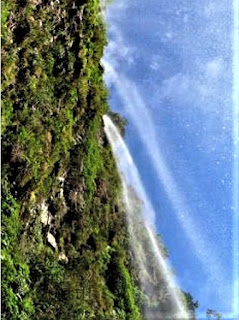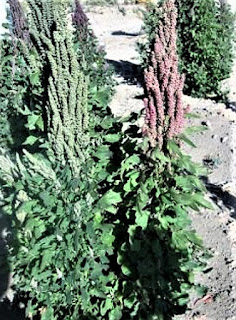La Paz
Though Bolivia is said to be very poor, in La Paz the pasar malam and the pasar pagi are really crowded. The morning market outside our hotel is several km long. Bolivians not that poor may be. One difference between the costumes of these people with the indigenous people at the Farmers' Market at Pisac in Peru: the Bolivians all wear high hats. Avocado and passion fruits are common here, and cheap too. The 1st photo shows crowd at the evening market near to our hotel.
The old Death Highway between La Paz and Coroico
See the steep slopes of the road, some eroded sections and water from the upper slope coming down onto the road (2nd photo). And a van carrying the bikes. See the narrow unpaved road surface.
The new highway between La Paz and Coroico
Most parts of the new highway are in fact improved sections of the old Death Highway, widened to multiple lanes, asphalt-surfaced, etc. But water still comes onto the road.
It snowed at the highest section in mid-summer. The alpacas and llamas also came out to play. The altitude at this high point is about 4,650 m.
Carnaval de Oruro
Oruro is a mining town with some 240,000 people, located at an altitude of 3,710 m. Simply famous for its annual carnival.
1st series : the setting, the revellers and a fatal victim of the spray war. Most revellers are armed with spray cans and participate in the spray war. All are victims and also culprits.
2nd series :the marching bands.
3rd series : the dancers, man and women, old and young, most in exotic costumes, with masks too, some dancers in erotic pose.
4th series: an armadillo float and the balloon man.
Salar de Uyuni / Eduardo Avaroa Andean Fauna National Reserve
1st series: our 4-wheel drives and the surface of the salt lake. And heaps of salt mined, not your "salty" salt, but gypsum. The vehicle carried more than people and our luggage, it carried its own fuel needed, and our rations for the 3 days. Simply dinners and breakfasts were provided at the basic unheated zero-star dorm-type hotels but lunches were taken on the road. There was a cook among the entourage for this purpose.
2nd series: lunch stop at Isle del Pescado, an island infested with giant Saguaro cactus, having pre-packed lunch under the mid-day sun.
3rd series: a night at the 0-star Salt Hotel, showing the dining room. Walls, floors, beds, tables, etc, all made of salt blocks. Home-generated electricity is available for a few hours only. Everybody charging their camera and phone batteries, from one power point.
4th series: a village, home-coming highland animals, and the Quinoa plant. Quinoa is the famed high-protein Incan rice.
5th series: mountains and rocks, altitude marker, and rail to nowhere (abandoned line to an abandoned mine, with abandoned wagons) in the Andean highlands. The famous weathered rock in the 5th photo is called “Stone Tree”.
6th series: lakes and flamingos. The lakes were mostly of different colours due to different prominent minerals in the water. The largest lake we passed by was Laguna Colorado, almost 60 sq km in surface area. The common flamingo species is the James’s Flamingo.
7th series: vegetation. The region is mostly barren. The grass in the 3rd photo is called Stipa Ichu, the Peruvian feather-grass, endemic to the Andean highland.
8th series: geysers and hot springs. Certainly nice to feel the hot air in the freezing cold morning. "Very nice to be inside the hot spring pool," LM says, "but when you come up, ......... er er er"
San Pedro de Atacama, Chile A town of some 3,000 people. We attended a mid-day mass at the small local church to celebrate Ash Wednesday, a Catholic festival.
































































No comments:
Post a Comment